
Bullet and Splinter Wound Care Page Menu: 1 2 3 4 5 6 7 8 9 10 Next>>
Bullet and Splinter Wound Care in the Golden Age of Piracy, Page 7
Step 2F: Keep Bullet and Splinter Wounds Open - Medicines Used
A variety of medicines were used to keep bullet and large splinter wounds open as well as perform other functions. This section looks at a variety of different types of medicines unique to such wounds being kept open including: encouraging the formation of pus, preventing unwanted humors from gathering or being created at the wound site, cleaning the wound, protecting the wound site, handling the eschar or scar tissue that formed, stopping bleeding, healing deep wounds and healing the fractures accompanying gunshot and splinter wounds.
Encouraging the Formation of Pus
An important use of medicines according to period surgeons was to bring a wound to suppuration - the formation of pus. Today we realize this occurs when the wound is infected. During the golden age of piracy it was believed to be the drawing together of corrupted humors at the wound site so that they could be ejected from the body and it could begin to heal properly.
Photo: Boris Dimitrov - Cur Puppies
Several authors mention specific suppurating medicines. Ambroise Paré says "you must use suppuratives, as you usually do in contusions; such as are oil of Whelpes [oleum catellorum - oil of puppies] and that which we call a digestive [a medicine used to encourage the growth of flesh in a wound]"1.
Richard Wiseman also suggests dressing contused wounds with this medicine, being as "hot as the Part will bear, not giving credit to any that shall persuade you to the contrary"2. Paré recommends continuing using the oil well into the treatment, noting that in later dressings the surgeon should add "the yolks of some egs and a little saffron; and use this medicin, until the Wound come to perfect suppuration"3.
Richard Wiseman also suggests the use of oil of turpentine mixed with a digestive medicine to bring about suppuration in gunshot wounds. However, he warns
you must have a care you do not inflame them and cause pain by adding too much of it: A Spoonful to six ounces of your Suppuratives is enough in the drest Habits [wound dressings]. Your judgment will best direct you, and your Patient’s complaint: It being unreasonable to hope that Wounds can digest, while they are accompanied with much Pain.4
Paré says that when a wound suppurates and "the quitture [referring here to pus] begins to flow from it... the pain and feaver are increased"5. So, examining Wiseman's comments in light of Paré's statement, a digestive would be a poor choice to mix with a medicine that promotes suppuration because the process of suppuration causes pain.
Sea surgeon John Woodall recommends suppuratives for wounds that
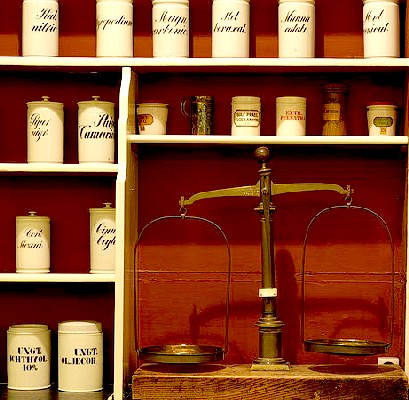
where an 'exudation of clammy humors' . However, Woodall's goal appears to be less about suppuration and more about ejecting the unwanted humors by whichever medicines work. He advises that such
humors are to be evacuated, or their dangers prevented by good alterative remedies, namely abstersive [cleaning or purging] medicines, as a good Lixivium [lye], or by supperative, mundifactive [cleansing], and desiccative [drying] things having faculty, confirming and strengthening the parts affected.6
Woodall is particularly fond of the use of lixivium in gunshot wounds, which shouldn't be surprising given the variety of diverse healing qualities he attributes to it. He goes on to say that "for the first intention of curing, it were fit the Surgion at Sea were never wanting of a good Lixivium, to foment the parts percussed or contused"7.
Some surgeons advise against the use of suppuratives at times. Paré forbids the use of suppuratives to heal contusions caused by gunshot in parts of the body where contain a lot of nerves (such as the joints) as well as in wounds that have begun 'putrefying' or decaying. He says, "For all nervous parts require dryer medicins... wherefore in Wounds of the joints and nervous parts you shall use more venice Turpentine [rather] than oil"8.
Before discussing the medicines to be used in putrefied wounds, it is important to understand what they are. According to John Quincy, 'putrefaction' comes from the Latin words which mean 'to make rotten'. He further defines it as "the Destruction of that Form of their Existance"9 which makes it sound rather dire. However, at this time in medicine, putrefaction at a wound site did not necessarily mean that it had become gangrenous and was beyond hope. Rather, it suggests that the humors were putrefied, being changed from their natural state to a corrupted one and so needed to be removed. Paré explains,
When Blood is corrupted in its thinner portion, it turns into Choler, when its thicker, into Melancholy; for the Blood because faulty two manner of ways, either by the corruption of its proper substance by putrefaction, or by the admixture of another substance by infection.10
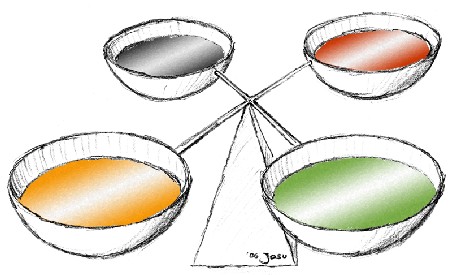
Artist: Jakob Suckale - Balance the Four Humors
Blood, choler and melancholy are three of the four humors believed to make up the body at this time. In order for the body and its parts to be healthy, the humors had to be in balance as well as uncorrupted. So the idea of fighting putrefaction at a wound site involved handling humors which were "against nature, which being corrupted, infect the body and the parts in which they are contained"11.
To combat corrupted humors, Paré recommended "such things as resist putrefaction" which included a topical ointment containing two ounces each of powdered alum, verdigris, Roman or blue vitriol, honey of roses in a sufficient quantity of yellow vinegar, all boiled together into the consistency of honey. He explains that this medicine will resist putrefaction
by reason of the heat and subtlety of the substance, [because it] hath a faculty to induce and attenuate the humors, as also to call forth the native heat drawn in & dissipated by the violent and forcible entrance of the Bullet into the body; furthermore also it corrects the venemous contagion of the virulent humor."12
Like Paré, Woodall recommends against suppuration in contused wounds until "feare of a Gangrene [has been] taken away", although, unlike Paré he recommends that when "in the parts contused there bee a vitious [vicious] humor, and the flesh [is] about to putrifie, in such cases it is convenient to helpe suppuration with all speed."13 Woodall here appears to recommend suppuration as a way to prevent putrefaction before it occurs, although how a surgeon could detect that putrefaction was imminent is not explained.
1 Ambroise Paré, The Workes of that Famous Chirurgion Ambrose Parey, 1649, p. 318; 2 Richard Wiseman, Several Chirurgicall Treatises, 1686, p. 413; 3 Paré, p. 319; 4 Richard Wiseman, Several Chirurgicall Treatises, 1686, p. 428; 5 Paré, p. 319; 6,7 John Woodall, the surgions mate, 1617, p. 142; 8 Paré, p. 319; 9 John Quincy, Lexicon Physico-Medicum, 1726, p. 393; 10,11 Paré, p. 11; 12 Paré, p. 318; 13 Woodall, p. 142
Preventing Unwanted Humors
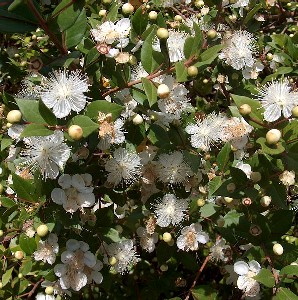
Photo: Giancarlo Dessi - Myrtle Flowers
In addition to drawing the humors out through suppuration, medicines could be used to prevent humors from flowing toward the wound site. Richard Wiseman recommends a compound topical application with this in mind:
Rx. ol lumbric. [oil of earthworms], Ros. [oil of roses] Myrtill. [oil of myrtle] {of each, 3 drams} aceti cochl. [horseradish?] {2 ea.} mix them. In the dressing, your Applications over the Wound and Parts circumjacent should be such as have a virtue to hinder the Flux [flow] of Humors and strengthen the Parts1.
When discussing the treatment of gunshot wounds with a fracture, Wiseman mentions a similar medicine to strengthen the wounded part and prevent humors from flowing into the wound. He recommends that the surgeon bathe a "fractured Arm cum ol. myrt. [with oil of mytles] & olivar. immatur. [oil pressed from unripe olives] and a little acetum [vinegar]"2.
1 Richard Wiseman, Several Chirurgicall Treatises, 1686, p. 413; 2 Wiseman, p. 426
Cleaning
These wounds had to be kept clean, particularly when they were suppurating, because they would ooze pus and other bodily fluids. A few suggestions are made for medicines used to clean gunshot and large splinter wounds.
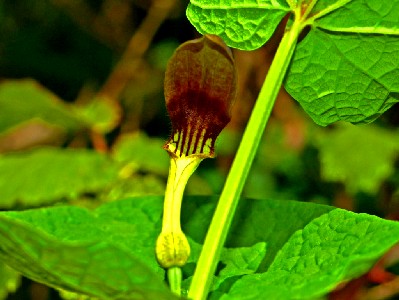
Photo: Wiki User Hectonichus - Aristolochia Rotunda
Ambroise Paré advises that after a wound has suppurated, a detersive or cleansing medicine must be added to the other medicines being applied to the wound. Such additives include "Turpentine washed in Rose [water], Barly [water], or some other such like water, which may wash away the biting thereof."1
Paré also recommends a complex medicine "to clense the filth, and wast[e] the spongious, putrid and dead flesh"2.
Rx. aq. hord. [barley water] {4 pints} agrimon. [agrimony] Centaur. minor. [lesser centaury] Pimpinellæ [pimpinella], absinth. Plantag. [plantain or plantago] {1/2 minum} rad. aristoloch. Rotund. [root of Aristolochia rotunda] {1/2 ounce} fiat decoction ad [make into a decoction of] {1 pint} in colatura expressa [expressed strained liquid] dissolve aloes hepaticæ. [the congealed juice of aloes] {3 drams} mellis ros. [honey of roses] {2 ounces} bulliant modicum [boil a little].3
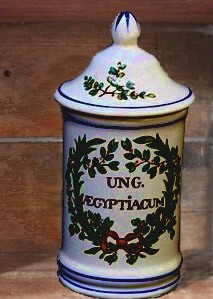
Photo: Giancarlo Dessi - Myrtle Flowers
Paré says that if this concoction fails to do the job,
you shall dissolve therein as much Ægyptiacum as you shall think fit for the present necessity; but commonly you shall dissolve an ounce of Ægyptiacum in a pint of the decoction. Verily Ægyptiacum doth powerfully consume the proud flesh [flesh growing where it shouldn't] which lies in the capacity of the Wound; besides also it only works upon such kind of flesh. For this purpose I have also made trial of the powder of Mercury, and burnt Alum equally mixed together, and found them very powerfull4
Aegyptiacum was reputed to have a particular ability to cleanse skin. Sea surgeon John Woodall recommended "your first locall application if you feare putrefaction, bee Ungu: Ægyptiacum mixed with Wine or Aquavitæ, or alone; being also very hot injected into the wound, or applied on linte."5 He explains in his description of this unguent that it "serveth to scower; it mundifieth [cleanses] all rotten foule ulcers, and is best to be put into the griefe scalding hot, and then the usuall paine and corrosion it procureth will be quickly past"6. He also says that it 'drieth vehemently' although he never mentions its use in removing unwanted flesh. Perhaps its drying faculty serves this purpose.
1,2,3 Ambroise Paré, The Workes of that Famous Chirurgion Ambrose Parey, 1649, p. 319; 4 Paré, p. 319-20; 5 John Woodall, the surgions mate, 1617, p. 143; 6 Woodall, p. 45
Protecting the Wound From Air
Air was believed to cause problems in wounds. Military surgeon William Clowes warned that "in hot and moist regions ...the air is most apt to increase putrefaction, insomuch that Butchers do refuse to kill flesh but for one day during the time."1 He further advised against staying in places where "loathsome and stinking venomous vapours are engendered, all which corrupt airs being received into their [patient's] bodies that are wounded with gun shot... [which] oftentimes do so breed venomous and poisoned wounds."2
Following this line of thought, some of the surgeons from this period recommend using medicines to protect these wounds from the air. Richard Wiseman said that it was "requisite you be furnished with some Cordials, to resist the putrid Vapours, and refresh the Spirits"3 for topical application.
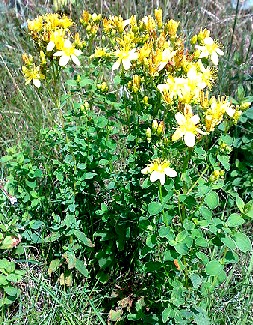
Photo: Wiki User Bjoertvedt
St. John's Wort (Hypericum Perforatum)
He goes to to suggest that such medicine be applied "externally by some Epithemata [lotion] of distilled Waters, as of Balm, Bugloss, Roses, acetum, with the Powder of the Roots of tormentill. Scordium, scorzonera, contrayerva, or other cordial Species"4.
Wiseman also suggested a compound liquid medicine to foment or bathe bullet wounds which was to be wrung out of a hot cloth. This medicine contained St. John's Wort flowers (summitatum hyperici), centaurum flowers, teucrium scordium flowers, absinth (wormwood), red rose flowers, chamomile flowers, melilote flowers, elder flowers (sambuci), bran (fururis), all cooked together and added to sour wine and brandy.5 He explained that it would "give a breathing to the Parts, and defend the Wound from Air while you consider it."6
The additional function of 'giving a breathing' sounds unusual when combined with defending the wound from air. However, just as the phrase 'breathe a vein' meant to open a vein to allow the blood to flow, giving a breathing to the wound suggests that the medicine would allow moisture and perspiration to leave the wound. (Sweating was considered a treatment which would purge bad humors from a site, so permitting perspiration would be considered a good idea.)
In one of his case studies during the later stages of treating a gunshot wound with a fracture, Wiseman suggests a much simpler method for this, explaining that he "fomented the member with warm Water, to give a breathing to it"5. This medicine did not protect the wound from air, of course.
Sea surgeon John Moyle recommended using a compound medicine of his own design to protect wounds from air when bandaging bullet wounds. "Let your bolster be wet in acetum, and apply the defensivum magnum above the Wound, and all about the part, and so roul it up for present."7 Moyle does not say anything about making sure the wound can breathe, however.
Another concern was to keep the patient from breathing 'bad' air. Ambroise Paré warns that

Artist: Jacob Cornelisz van Oostsanen - Man & Pomander (1518)
there are some times wherein even small Wounds made by Gunshot prove deadly, not by their own fault, but the fault of the air; therefore also the Chirurgeon must have this care, that he corrects the aire [the patient is breathing] with all diligence, & reduce it to a certain quality and moderation of substance, and strengthen the noble parts and whole body8.
The idea behind this appears to be the good air was required to strengthen the body and allow it to resist the gathering and corruption of humors at the wound site. Paré advised the surgeon to "frequently put odiferous and refrigerating [cooling] things to the Patients nose, to strengthen the animall faculty... using "a linnen rag dipped [in such medicines... now and then put to the Patients nose; for that same purpose he shall carry a Pomander about him, and often smell there."9 For this purpose, he prescribes: "Rx. aquæ rosar. [rose water] & aceti boni [good vinegar] {of each 3 ounces} caryophyllorium ]cloves], nucis moschat. [nutmeg] Cinamomi, conquassatorum [shaken together], & Theriacæ Galeni [Greek treacle], {of each one dram}"10.
Paré also suggests something a bit more difficult to achieve on a ship to get 'healthful' air into the patient's respiratory system. "You shall make a fire, in the Patients chamber of odoriferous woods, as Juniper, Bay-tree, the prunings or cuttings of Vines, Rosemary, and Orris [iris] roots."11 However, it is unlikely that this would normally be practiced at sea due to restrictions on open flames in the wooden, oakum and canvas world of a sea-going vessel.
1 William Clowes, Selected Writings of William Clowes, 1948, p. 138; 2 Richard Wiseman, Several Chirurgicall Treatises, 1686, p. 415; 3,4 Wiseman, p. 414; 5 Wiseman, p. 414-5; 6 Wiseman, p. 415; 7 John Moyle, Chirugius Marinus: Or, The Sea Chirurgeon, 1693, p. 70; 8.9,10,11 Ambroise Paré, The Workes of that Famous Chirurgion Ambrose Parey, 1649, p. 322
Handling the Eschar
Although dealing with eschars from a surgical standpoint has already been discussed, medicines were also sometimes used.
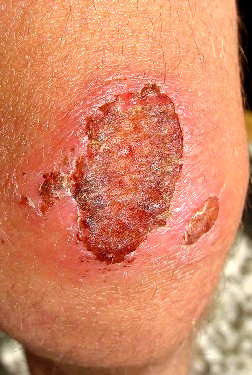
Photo: Wiki User ALEF7 - A Dry Eschar
To allow free passage of pus and other fluids from such deep wounds, softening medicines were used to weaken the eschar.1 Richard Wiseman recommended "[Mercury] Præcipitate and axungia [lard] with a few drops of ol. terebinth. [oil of turpentine] ...it being a good Remedy to resist Putrefaction, and hasten separation of the Eschars."2
In addition to breaking eschars up, embrocations were used to preserve eschars by keeping them from becoming too dry. *While eschars could be a problem during suppuration, they were also necessary to protect the wound while it was healing.) Wiseman warns his readers that although gunshot and splinter wounds may appear black, it was not wise to dress the wound as if it were gangrened. (Gangrened skin also appeared to be black and dead.) He specifically advises against the instinct to dress such wounds
with spir. Vini and unguent. Ægyptiac... [for otherwise] the Eschar will grow dry and parched, and the Humours which flow plentifully to it will cause an Inflammation with Tumour, and an Apostemation [pus filled abscess] is the best that can be expected underneath the Eschar, and consequently it will terminate in a hollow Ulcer3
Instead, he advises the use of soothing medicines, seeing that "the Parts about [were] embrocated with ol. ros.[oil of roses] cum album. ovor. [with egg yolk] & aceto [vinegar]" with a medicine over that to prevent discharges.4
1 Richard Wiseman, Several Chirurgicall Treatises, 1686, p. 428; 2 Wiseman, p. 413; 3,4 Wiseman, p. 408
Stopping Bleeding
Some of the period surgeons used restrictive medicine to stop bleeding in these wounds. While treating a gunshot wound with fracture, Richard Wiseman mentions the use of a restrictive medicine (one that stops bleeding), although he doesn't say which one he used.1
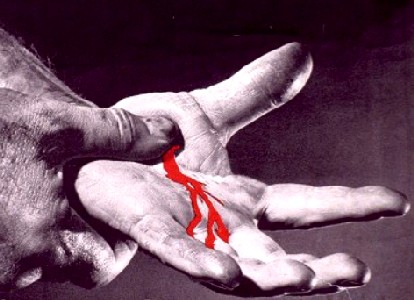
Two sea surgeons under study used medicines to stop bleeding when treating such wounds.
John Moyle recommends the use of styptic medicines several times. After removing a bullet from a man, Moyle advised "keeping the Man in the same posture still [as when he received the gunshot wound], take a Tent dipt in Acetum [vinegar], or Aq. Stipt. [Aqua Stypitica] and then rouled in Pulv. restring. maj. [pulverised restringens major] and apply it into the Wound"2. Styptic water is a medicine unique to Moyle's book, while the powdered restrigent had wider use.
Moyle mentions restrictive medicines elsewhere in treating these wounds, directing the surgeon to "apply soft Dorcels [dossils - folded lint pads] wet in Aqua Stiptica, and dipt in restringent Pouder, into the Wound, and on them a Pledgit [basically the same thing as a dossel] armed with restiva maxima."3 Rest[ric]tiva maxima is the powdered restringens major combined with vinegar and egg white to give it more even strength when stopping bleeding.
When treating 'percussed and contused' wounds such as those made by gunshot and large splinters, John Woodall advised his readers to "have ready... a good Restrictive powder"4. Woodall is likely referring to pulvis restringens major here.
1 Richard Wiseman, Several Chirurgicall Treatises, 1686, p. 427; 2 John Moyle, Chirugius Marinus: Or, The Sea Chirurgeon, 1693, p. 74-5; 3 Moyle, p. 70; 4 John Woodall, the surgions mate, 1617, p. 142;
Healing Deep Wounds
Photo: Wiki User Mattes
Unguent of Basilicum
A variety of medicines were used to heal gunshot and large splinter wounds. Medicines used to generate tissue in wounds were referred to as digestives1 and incarnatives (medicine to incarnate or generate flesh). Ambroise Paré says that "the chief of the cure must be to heal the contusion... This shall be done by medicins taken inwardly, applied outwardly, and put into the Wound"2.
For healing the inside of a deep gunshot wound, John Moyle suggested the use of either linamentum compositum or basilicon compound (unguent). Both were said to have the ability to generate flesh, among other things. The liniment is actually composed of a couple of other complex medicines reputed to have the ability to cleanse, soften and generate flesh in a wound. The basilicon, which Moyle refers to as "the old standing Medicine" for healing such wounds3, is considered both a digestive and an incarnative4, one so effective that one physician warns that "it is sometimes apt to incarn too fast"5.
A large number of other medicines were recommended for application to wounds that were not as deep which would be appropriate here. However, these have already been covered in some detail in the article on Simple Wounds (found here).
1 For example, see John Atkins, The Navy Surgeon, 1742, p. 149; 2 Ambroise Paré, The Workes of that Famous Chirurgion Ambrose Parey, 1649, p. 318; 3 John Moyle, Chirugius Marinus: Or, The Sea Chirurgeon, 1693, p. 72-3; 4 John Woodall, the surgions mate, 1617, p. 44; 5 John Quincy, Pharmacopoeia Officinalis & Extemporanea, 1719, p. 454
Healing Fractures
When dealing with gunshot and large splinter wounds with accompanying fractures, period authors mention a couple of other interesting uses of medicines.
Ambroise Paré recommends two complex medicines for drawing small splinters of bone which have been 'broken
and shattered asunder by the violence of the stroak' and cannot be removed by the
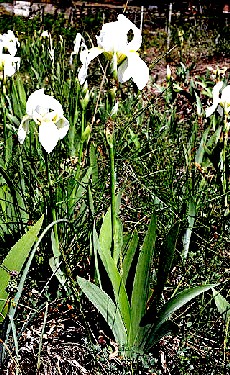
Photo: Alessandra Perugi - Iris Florentina
surgeon. His prescriptions (split into two separate entries here for clarity) include:
Rx. radic. Ireos Floren. [iris florentina root] Panac. [iris florentina plant] & cappat. [iris florentina tops (flowers)] {of each 3 ounces} aristoloch. rotund. mannæ [dew from Aristolochia rotunda], thuris [powdered frankicense], {of each one dram} in pollinem redacta incorporentur cum melle [incorporated into powder with] rosar. [probably rose water] & terebinth. venet. [Venetian turpentine] {of each 2 ounces} or
Rx. resin pini siccæ [dried pine resin] {3 ounces} pumicis combusti [burnt or calcined pumice] & extincti in vino albo [quenched in white wine], radic. Ireos aristolochiæ [iris florentina root], {of each ½ dram} thuris [powdered frankicense] {1 dram} squamæ æris [brass scales - thin pieces or shavings of brass], {2 drams} in pollinem redigantur [reduced to powder], incorporentur cum melle rosato [combined with honey of roses], fiat medicamentum [make into a medicine]1
Richard Wiseman suggests a medicine for dressing the ends of exposed bones in fractures. He advises "Dossils [folded pieces of lint] dipt inspir. vini [brandy] and Merc. præcipitat. [white mercury precipitate], with some little ol. terebinth. [oil of turpentine]"2. Although he does not say so, it is likely that the purpose of this medicine is to encourage the end of the bone to scale or flake off which was thought to be necessary for healing of the bone to begin.
Wiseman also recommends in one of his case studies where a fracture was accompanied with 'troublesome' itching, he "bathed the member with Seawater, and drest him up with emplast. de lithargyro. [a lead-based medicated plaster, which serves as a powerful astringent]"3.
A variety of other medicines are appropriate for treating fractures are discussed here.
1 Ambroise Paré, The Workes of that Famous Chirurgion Ambrose Parey, 1649, p. 320; 2 Richard Wiseman, Several Chirurgicall Treatises, 1686, p. 426; 3 Wiseman, p. 427

